Pressure Relief Valve
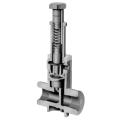
Series RVDM In-Line Pressure Relief Valves feature a primary rolling diaphragm and secondary flat diaphragm which incorporates the Plast-O-Matic patented Fail-Dry® design for added protection. If the rolling diaphragm should fail, liquid will weep through the vent port which is located between the two diaphragms. Leakage indicates maintenance is required and can be conveniently scheduled, eliminating an emergency shutdown. Series RVDM valves are supplied with adjustment screws so that the user can make his own setting according to pressure requirements. Pressure settings can also be made at the factory to customer’s requirements. RVDM valves can be set from 5 to 100 psi (5 to 120 psi for 1/2" size) by simply turning the adjusting bolt.
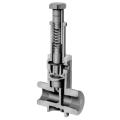
Series RVDM In-Line Pressure Relief Valves feature a primary rolling diaphragm and secondary flat diaphragm which incorporates the Plast-O-Matic patented Fail-Dry® design for added protection. If the rolling diaphragm should fail, liquid will weep through the vent port which is located between the two diaphragms. Leakage indicates maintenance is required and can be conveniently scheduled, eliminating an emergency shutdown. Series RVDM valves are supplied with adjustment screws so that the user can make his own setting according to pressure requirements. Pressure settings can also be made at the factory to customer’s requirements. RVDM valves can be set from 5 to 100 psi (5 to 120 psi for 1/2" size) by simply turning the adjusting bolt.
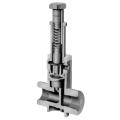
Series RVDM In-Line Pressure Relief Valves feature a primary rolling diaphragm and secondary flat diaphragm which incorporates the Plast-O-Matic patented Fail-Dry® design for added protection. If the rolling diaphragm should fail, liquid will weep through the vent port which is located between the two diaphragms. Leakage indicates maintenance is required and can be conveniently scheduled, eliminating an emergency shutdown. Series RVDM valves are supplied with adjustment screws so that the user can make his own setting according to pressure requirements. Pressure settings can also be made at the factory to customer’s requirements. RVDM valves can be set from 5 to 100 psi (5 to 120 psi for 1/2" size) by simply turning the adjusting bolt.
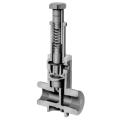
Series RVDM In-Line Pressure Relief Valves feature a primary rolling diaphragm and secondary flat diaphragm which incorporates the Plast-O-Matic patented Fail-Dry® design for added protection. If the rolling diaphragm should fail, liquid will weep through the vent port which is located between the two diaphragms. Leakage indicates maintenance is required and can be conveniently scheduled, eliminating an emergency shutdown. Series RVDM valves are supplied with adjustment screws so that the user can make his own setting according to pressure requirements. Pressure settings can also be made at the factory to customer’s requirements. RVDM valves can be set from 5 to 100 psi (5 to 120 psi for 1/2" size) by simply turning the adjusting bolt.
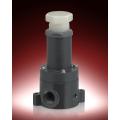
Series RVDT In-Line Pressure Relief Valves feature a wetted flat PTFE diaphragm to resist both chemical attack and salt crystallization problems. A large, active diaphragm area provides for smooth, chatter-free operation. Relief setting is infinitely adjustable from 5 PSI to 100 PSI. This design functions as a relief valve, by-pass valve, back-pressure valve and anti-siphon valve. The Relief Function protects systems and equipment from over-pressure and pressure surges. The By-Pass Function prevents pumps from “dead-heading”. The Back- Pressure Function maintains necessary reverse pressure in closed-loop systems. The Anti- Siphon Function prevents unwanted chemical siphoning, if city water pressure drops to zero, and changes in elevation create negative pressure. Series RVDT relief valves are constructed of Type 1, Grade 1 PVC, CPVC, Polypropylene, PTFE or PVDF Kynar® body materials. The wetted diaphragm is PTFE, energized by a non-wetted Viton® diaphragm. Springs (not in wetted area) are zinc-plated steel, fasteners are stainless steel and the adjusting screw is polyethylene.
